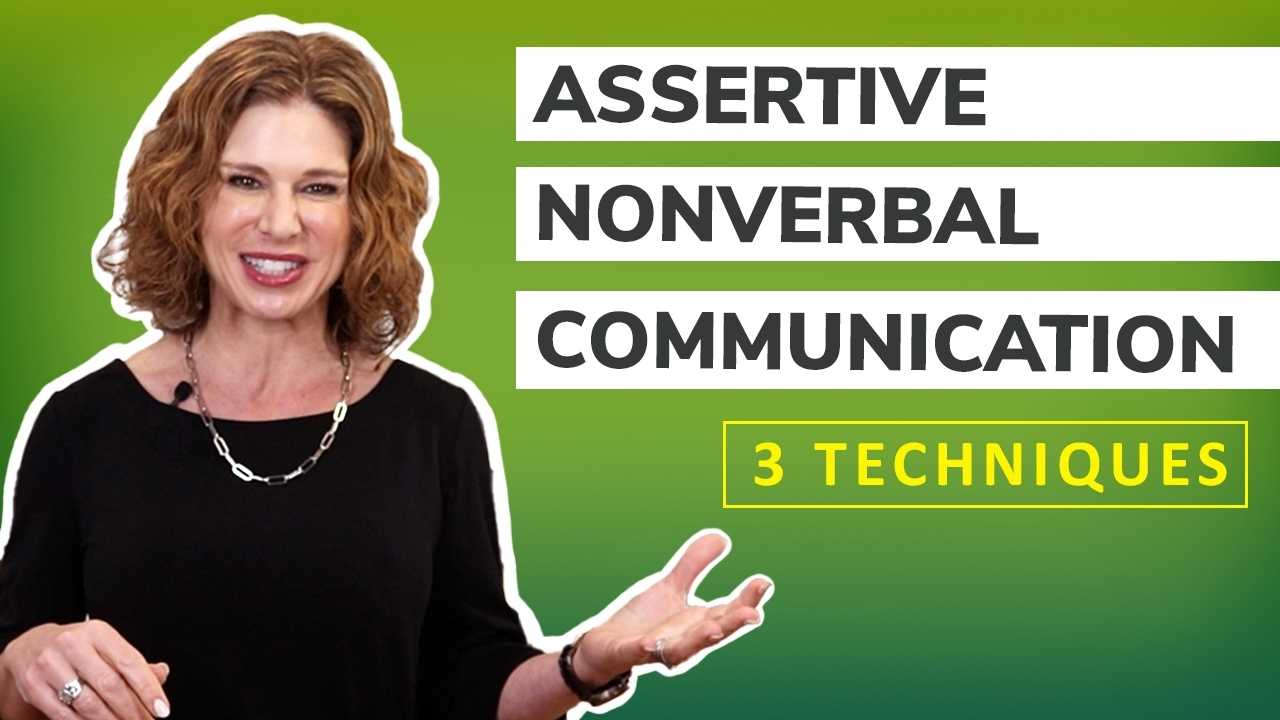Did you know that according to studies, 55% of your credibility and your authority is based on your body language?
Stay tuned today on Moxie Talk, we are going to unpack how to have assertive and confident non-verbal communication.
---
Hi everyone, I’m Fia Fasbinder welcome to Moxie Talk where we help you find your voice, share your message, and lead with confidence. Before I get started on today's blog, if you watch me on youtube please make sure to hit that alert button so you get notified of all of my new content, and please subscribe to our channel.
In today's blog, we are going to unpack assertive non-verbal communication. By non-verbal I mean body language, eye contact, posture, facial reactions.
As a reminder, if you're interested in assertive communication skills in general please check out my other blogs on assertive phrases or having an assertive voice, or how to practice assertive communication.
Before I dive into my 3 go-to techniques for assertive non-verbal communication, I want to introduce you to one of my favorite all-time studies —
The Mehrabian Study.
The Mehrabian study was done at Stanford University and it examined an audience's perception of a speaker's credibility based on 3 areas:
- Nonverbal communication
- Tone of voice
- Content
and the numbers are astounding.
55% of the audience's perception of the speaker's credibility was based on body language.
55%! which is more than half.
38% was based on tone of voice,
and only
7% was based on content.
This is not to say that the content of your assertive messages is not important.
It is important! That's why I did a whole blog on phrases you can use and practice but this is to say that the way you deliver that message and your body language can make or break your perception of assertiveness and credibility.
All of you can probably think of a time in your head where you have seen somebody you don't know and before they even start speaking you can tell that they're nervous. When I talk about this in my workshops, I ask my participants 'How can you tell they're nervous?'
Usually, I'll hear things like small body language or eyes are averted or hands crossed or handshaking. All of these although they're just signs that this person is nervous also undermine our credibility and our audience discredits us and at the best, they feel sorry for us.
Obviously, if we are working on assertive communication the last thing we want is for our body language to undermine our assertiveness. So let's talk about ways that you can use assertive non-verbal communication.
---
Technique 1: Eye Contact
Now that you understand the importance of assertive non-verbal communication, let's break it down. My first go-to technique is eye contact.
Maintaining eye contact with the person you're speaking to helps you to stay focused. It's also an easy way to let that other person know that you care about what they're saying and you're invested in the conversation.
Experts even say that how you direct your eyes and how long you keep your eye contact can be even more important than what you say, so that goes back to that Mehrabian Study.
Eye contact is the nonverbal equivalent of speaking to a person and using their name.
Eye contact is really the non-verbal equivalent of saying somebody's name and letting them know that you're present and you're ready to have a conversation.
I know this can be a difficult and stressful situation. We tend to go inward or we avert our eye contact because it feels vulnerable or difficult to maintain eye contact in stressful situations or when you are practicing assertive communication.
For introverts, I know this can be especially difficult but by now you probably know that my solution for any difficult behavior change or new skill is to practice.
Therefore, begin by practicing with people in your lives that you feel comfortable with. Notice how long on average you maintain eye contact when you're speaking to those people and they're speaking back to you.
Next, try to maintain eye contact with people you're not as comfortable with but in a non-stressful situation like a colleague at work or a stranger at the grocery store or somebody that you begin a conversation with that you don't know — this will help you build up the tenacity and the muscle to maintain eye contact when you need it in those high-stakes situations.
You're going to find that maintaining eye contact requires you to be present. Mindfulness means being present not thinking about anything else or anyone else who's not currently around you.
So forget about the rest of the world, look at the person you're communicating with at that moment and listen actively to everything they're saying.
Put down our weapons of mass distraction
This means for many of us that we have to put down our technology and our devices which I call weapons of mass distraction. Truly listen to the person that we are speaking to in that situation and just this alone will help you communicate with so much more assertiveness.
---
Technique 2: Strong Body Language
Technique number 2 for assertive nonverbal communication is strong body language.
When we get nervous we naturally make ourselves small because in our caveman or cavewomen days, when we were at danger in danger or at risk it would be helpful to be inconspicuous— to not be seen.
Obviously, this is an ancient reaction that is not helpful now because closing ourselves off definitely doesn't amplify our message of assertiveness. In fact, by closing ourselves off we look nervous we look meek and sometimes we look literally closed off to the conversation.
The antidote to this is open strong body language and there are 2 ways to do this—
One way that I use with my clients is to imagine a string, that's invisible and one half is attached to the middle of your head and the other half is attached to the ceiling and it is gently pulling you up and softening that S-curve in your spine. Hence, instead of getting your body smaller or like a close chest cavity, you are gently pulling up.
Then with your shoulders, if you find yourself crossing your hand, going slumped, looking down; you want to imagine that if I were to cut you in half from top to bottom, your shoulders would be in the back of that part of the body that I cut in half — they would be in the back, not in front.
This is an easy visual to remember how to open and how to be strong. It is basically what our parents told us growing up all the time — 'Don't slouch!' 'Be open!' 'Sit tall or Stand tall'.
It's really easier than you think simply by imagining that string and imagining that your shoulders are on the back half of your body not the front.
These simple tweaks to your body language will not only make you appear to be much more assertive in your non-verbal communication but you'll actually start to feel more assertive and more confident
You'll not only look different, you'll feel different
If you want a deep dive into non-verbal communication and how to tweak your non-verbals to be more confident, I highly recommend you check out Amy Cuddy's Ted Talk called Your body language shapes who you are.
It is one of the top Ted Talks in the world. It's been viewed millions of times and it really dives into this idea that minor tweaks to our body language not only change the way people see us but change the way we feel about ourselves.
Another great technique that you can use is called
The Happy Warrior.
I mentioned this in some of my previous blogs but the happy warrior is this idea that — great leaders have a combination of strength and warmth that makes us follow them into any situation.
A combination of strength and warmth.
These could be political leaders or leaders at your work or community leaders or leaders at a church or a synagogue. These leaders all have this combination of strength and warmth that makes us trust them.
On that account, one of the ways that you can balance strength and warmth is strong body language by standing tall and keeping your shoulders back but balancing that with eye contact which would be warm or a warm tone of voice.
Therefore, finding that balance so that you can convey a happy warrior in your assertive nonverbal communication is really where it's at.
---
Technique 3: Practice
My last pointer is to practice impromptu assertiveness. You knew I was going to say that, right?
Practice is the solution to so many problems here at Moxie and the answer to the question that I get asked over and over by my clients "How can I appear natural and confident when I have to be assertive or confident on the fly?"
It can often be so hard to know how to get your feelings across confidently and clearly to someone when you need to assert yourself — especially in stressful or high-stakes situation.
Script out and practice conversations
One technique that can help help you is to script it out. Script out the conversation and then practice it because it allows you to prepare what you want to say in advance. Once you internalize and master the steps to this, you can do it easily in your head and apply it on the fly in so many situations.
Here is an easy four-pronged approach that I use with my clients in assertiveness training:
Script The Event
The first thing you're going to script is the event. You want to tell the other person exactly how you see the situation or the problem. Here's an example 'Janine, the production costs this month are 23% higher than average. You didn't give me any indication of this which meant that I was completely surprised about the news.'
Script How You Describe Your Feeling
Next, you want to talk about your feelings — How this made you feel. You want to describe how you feel about the situation and express your emotions clearly but calmly. Do not let your emotions override the situation.
Look you're talking about your emotions but you're not going to let them lead the conversation. For example, you could say something like— 'This frustrates me and it makes me feel like you don't understand or appreciate how important financial controls are in the company.'
Notice I didn't say 'You don't understand or appreciate how important they are' this is not showing assertiveness. That is on the aggressive side so we want to make sure that we maintain composure when we're talking about our feelings.
Script How You Would Communicate Your Needs
Next, you want to talk about your needs— that's number three. Tell the other person exactly what you need from them so they don't have to guess, they don't have to look into a crystal ball.
For example, you could say 'I need you to be honest with me and let me know when we start to go significantly over budget on anything'.
Script Out The Consequence
Then the last step in your scripting would be the consequence which is to describe the positive impact that your request will have on the other person or company if they meet your needs successfully.
Notice I said positive effect. You don't want to go to the negative, you want to keep it positive— this is how you get the buy-in. For example, you could say 'If you do this, we will be in a great position to hit our targets and we may even get a better end-of-year bonus'.
So that's what you do — you script it and then you practice.
- Script it! practice!
- Script it! practice!
and what you're going to find is,
One day, you'll surprise yourself with how confident you sound.
You will eventually internalize not only the four-pronged response but also the non-verbals, the vocal quality needed for assertive communication and this will be so much easier to do and to pull out of your back pocket when you most need it
There you go, three pre-powerful and proven techniques to make your assertive body language match your assertive message. Ee talked about eye contact, power posing, and practice.
If you know anybody that would benefit from some guidance around assertive communication skills, please make sure to share this blog. Share our Youtube videos, subscribe to our channel, and like the videos.
If you want to take a live class where you can get feedback in real-time from a Moxie Master Trainer, check out our website. You can sign up right there for one of our live online classes. We’d love to have you!
We will see you next time and until then remember to live boldly, lead brilliantly and Speak with Moxie.















